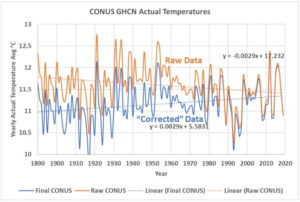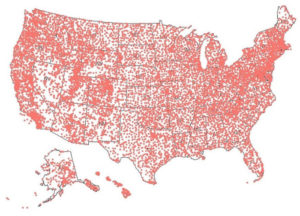by Andy May, Nov 24, 2020 in WUWT
The United States has a very dense population of weather stations, data from them is collected and processed by NOAA/NCEI to compute the National Temperature Index. The index is an average temperature for the nation and used to show if the U.S. is warming. The data is stored by NOAA/NCEI in their GHCN or “Global Historical Climatology Network” database. GHCN-Daily contains the quality-controlled raw data, which is subsequently corrected and then used to populate GHCN-Monthly, a database of monthly averages, both raw and final. I downloaded version 4.0.1 of the GHCN-Monthly database on October 10, 2020. At that time, it had 27,519 stations globally and 12,514 (45%) of them were in the United States, including Alaska and Hawaii. Of the 12,514 U.S. stations, 11,969 of them are in “CONUS,” the conterminous lower 48 states. The current station coverage is shown in Figure 1.
Figure 1. The GHCN weather station coverage in the United States is very good, except for northern Alaska. There are two stations in the western Pacific that are not shown.
…

igure 4. The orange line is the uncorrected monthly mean temperature, which is “qcu” in NOAA terminology. The blue line is corrected, or NOAA’s “qcf.”
…
…

